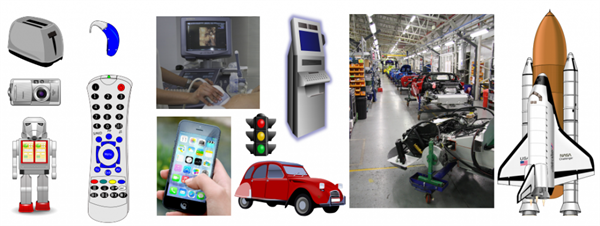What is control?
Control is making instructions that change the physical world and, in upper Primary, it includes the use of sensors to influence what needs to be done. For example, instructions control an automatic door to open when motion sensors detect someone approaching, but don’t open if they detect someone is in the way. Sensors, such as those for motion, temperature, sound and light, are the inputs to control systems, and are processed to control outputs such as motors, speakers and lights.
Examples of control systems include toasters, cameras, electronic toys, hearing aids, remote controls, medical scanners, mobile phones, traffic lights, ATMs, cars, car assembly lines, space shuttles, automated passenger barriers, and automated greenhouses; in fact, anything automated that creates a physical output using some kind of sensor or input.

Control systems are all around us, from the everyday toaster to the space shuttle. Car assembly line photographed by Brian Snelson, originally posted to Flickr as Final Assembly via Wikimedia Commons [CC-BY-2.0 (http://creativecommons.org/licenses/by/2.0)]. All other images public domain (Wikimedia or Pixabay).
Automated control systems are all around us. They can be a single computer embedded within an everyday object, such as the on/off controller of a central-heating thermostat, or a combination of various computer systems all working together, such as in a car assembly line. Control systems don’t always involve computers. A pipe organ uses pressurized air and mechanics, whilst a vintage aircraft uses wires and levers.
A program to control a lift processes inputs of distance information to slow the speed to zero as the correct floor approaches: where sensors measure the effect of output signals, systems can continually respond to any variance, creating new inputs which can be checked against the intended result – a process known as feedback. Our bodies use feedback themselves, for example to regulate body temperature.
Why is control important?
Control systems infuse modern life. Without control, our automatic kettle would not switch itself off when the water boils, our car would not stop as we apply the brakes, and an ATM would not dispense the requested cash. Computers themselves are control systems: they take input, process it and create physical outputs, but we often forget that our washing machines, microwaves and other electronic devices each have sensors, a processor and some form of physical output - they are control systems too. Other examples are traffic lights, cameras and medical scanners, mobile phones, flight simulators and space shuttles. Frequently, computer control programs deal with analogue information from the ‘real world’; however, computers themselves work with digital data, meaning a key function of input and output devices is to convert between these two formats.

A nuclear power plant and an everyday smoke alarm are examples of control systems which we rely upon.